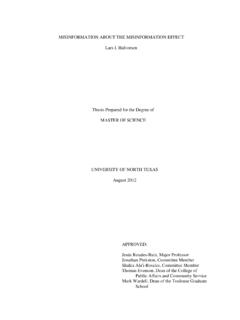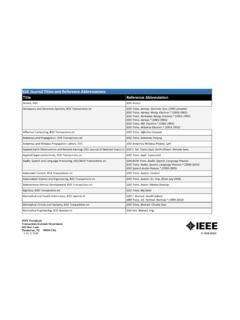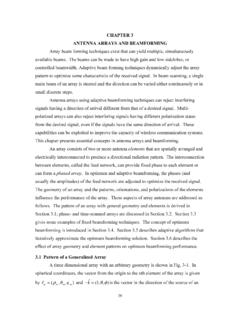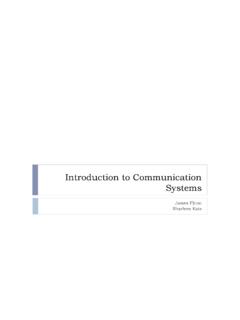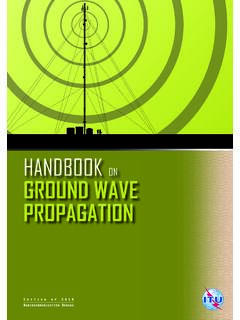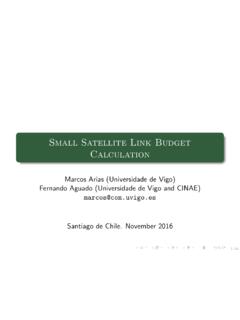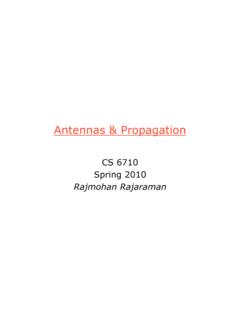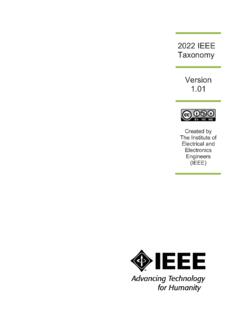Transcription of Radio frequency propagation differences through various ...
1 APPROVED: Perry R. McNeill, Major Professor Richard White, Co-Major Professor David Shelton, AT&T Wireless Services, Industry Representative Michael R. Kozak, Committee Member Roman Stemprok, Committee Member Fredrik Williams, Committee Member Robert L. Getty, Committee Member Albert B. Grubbs, Jr., Chair of the Department of Engineering Technology C. Neal Tate, Dean of the Robert B. Toulouse School of Graduate Studies Radio frequency propagation differences through various TRANSMISSIVE MATERIALS Patrick L. Ryan, Thesis Prepared for the Degree of MASTER OF SCIENCE UNIVERSITY OF NORTH TEXAS December 2002 Ryan, Patrick L., Radio frequency propagation differences through various transmissive materials. Master of Science (Engineering Technology), December 2002, 87 pp., 7 tables, 12 illustrations, references, 47 titles. The purpose of this research was to determine which of the commonly used wireless telecommunication site concealment materials has the least effect on signal potency.
2 The tested materials were Tuff Span fiberglass panels manufactured by Enduro Composite Systems, Lexan XL-1 polycarbonate plastic manufactured by GE Corporation and Styrofoam polystyrene board manufactured by The Dow Chemical Company. Testing was conducted in a double electrically isolated copper mesh screen room at the University of North Texas Engineering Technology Building in Denton, Texas. Analysis of the data found no differences exist between the Radio frequency transmissiveness of these products at broadband personal communication service frequencies. However, differences in the signal do exist with regards to the angle of incidence between the material and the transmitting antenna . ii Copyright 2002 By Patrick L. Ryan iii ACKNOWLEDGMENTS I express my gratitude to my advisor and major professor Dr. Perry R. McNeill. His attention to detail, encouragement, and guidance have been necessary for this thesis.
3 I thank my graduate coordinator Dr. Michael R. Kozak for his confidence, encouragement and guidance throughout my graduate program and in writing this thesis. I thank the Engineering Technology Department, University of North Texas and specifically, Dr. Albert B. Grubbs, for supplying the specialized equipment and screen room for this project. I appreciate the availability of such state-of-the-art facilities and staff assistance for this research project. I thank David Shelton of AT&T Wireless for his curiosity, knowledge, guidance and support on this project. I express my gratitude to my committee members Dr. Richard White, Dr. Roman Stemprok, Dr. Fredrik Williams and Dr. Robert L. Getty for their guidance. I thank Mr. Richard Locke, Enduro Systems, Inc. of Fort Worth, Texas, for donating the Tuff Span sheet stock for this study. I thank Richard Rodriguez, Director of SpectraSite Construction, Inc.
4 , San Antonio, Texas, for donating the antennas and lending his support. I thank Kerry Senum, who donated the transmission cable and connectors as well as his time, energy, equipment and expertise to complete the verification testing of the installed system. Thank you, Brian Urban, for your curiosity, support and assistance with equipment and hardware from the Engineering Technology Department. iv TABLE OF CONTENTS Page LIST OF LIST OF Chapter 1. Purpose of the Study Statement of the Problem Significance of the Study Research Questions Assumptions Limitations 2. REVIEW OF Electromagnetic Wave propagation Wave Properties of Radio waves Optical Properties of Radio waves Software 3. Research Design Materials Equipment LabVIEW Software v 4. ANALYSIS AND 5. CONCLUSIONS AND APPENDIX A LabVIEW APPENDIX B DATA LOG APPENDIX C SAMPLE OF EXPERIMENTAL APPENDIX D STATISTICAL ANALYSIS APPENDIX E TUKEY STATISTICAL ANALYSIS APPENDIX F CALCULATIONS OF BREWSTER S ANGLE AND MATERIAL APPENDIX G EQUIPMENT CALIBRATION APPENDIX H CABLE SYSTEM TEST APPENDIX I antenna TEST vi LIST OF TABLES Table Page 1.
5 Refractive and dielectric constants for tested 2. Brewster s angle for tested materials with dielectric constants restated ..16 3. Calculated losses for materials and angles of 4. Calculated differences from free space path loss ..20 5. Material test results vs. angles of 6. Two-factor ANOVA of test 7. Tukey procedure results for angles of vii LIST OF ILLUSTRATIONS Figure Page 1. System path 2. Wavefront from a point 3. Spherical wavefront from a point 4. Snell s Law of reflection and 5. Transmission line approach to compute reflected and transmitted 6. Diffraction angle of tested 7. Calculated path loss values vs. angle of 8. Angle of incidence tested per 9. Overhead view of screen room testing 10. Side view of screen room testing 11. Front panel of Thesis ..27 12. Tested path loss values vs. angle of 1 CHAPTER 1 INTRODUCTION The growth and popularity of mobile communication requires the installation of transmission towers in diverse locations.
6 Wireless service providers are increasingly required to camouflage or screen tower placements to hide them from public view. In fact, many municipalities require the use of such aesthetically pleasing structures to maintain the beauty of their skylines. Radio frequency (RF) waves are a form of electromagnetic waves used in the communication bandwidths defined by the Federal Communications Commission (FCC) [44]. Companies have emerged in the telecommunication marketplace selling site concealment solutions that use polycarbonate plastic in sheet-stock form like Lexan , manufactured by GE Corporation; glass reinforced polyester sheet-stock like Tuff Span fiberglass manufactured by Enduro Composite Systems; and polystyrene foam sheet-stock like Styrofoam manufactured by The Dow Chemical Company. Issues and questions surrounding the subject of RF site concealment will be explored to formulate hypotheses concerning which material has better RF penetration.
7 Answers to questions like, Which product should be used to affect maximum RF penetration with minimal costs for my site? will be addressed and answered. Using certain limitations and assumptions, the expectation is to show polystyrene foam as the clear choice for concealment products in personal communication services (PCS) frequency levels. 2 Purpose of the Study Known optimization of transmission signals through materials aids in site selection, tuning and maintenance, increasing the efficiency of the network and reducing the overall number of sites required to meet capacity. The purpose of this research is to determine which of the most commonly used site concealment materials (Styrofoam, Lexan and Tuff Span) has the least effect on signal potency. Statement of the Problem The problem is optimizing RF propagation at broadband PCS frequencies through polycarbonate plastic in sheet-stock form (Lexan), glass reinforced polyester sheet-stock (Tuff Span) and polystyrene foam sheet-stock (Styrofoam) to provide concealment of tower mounted telecommunication sites.
8 Significance of the Study The study should show superior RF propagation through polystyrene over other types of products, affecting the sales and marketing programs of companies that do not deal in polystyrene. RF engineers will have concrete evidence to support their choice of concealment products and will be able to show advantages and disadvantages of competing concealment types. Average base site construction costs, excluding Radio equipment, are $175,000. In addition, average concealment costs per site range from $5,000 to $100,000, which is 3% to 57% of the base construction cost for a concealment site. The results of this study may reduce these concealment costs, or at least reduce the range of costs used for budgeting of site construction. 3 Research Questions There are two research questions addressed in this study and defined below for hypothesis testing: 1. Question: Which product has the least effect on electromagnetic wave propagation ; Lexan, Tuff Span or Styrofoam?
9 Null: There is no difference in signal transmission through Styrofoam, Lexan and Tuff Span panels at PCS frequency levels. Ho1: Tst = Tlx = Tts Alternative: There is a difference in signal transmission through at least two of the materials at PCS frequency levels. Ha1: Tst Tlx Tts 2. Question: Does the angle of incidence to the material affect the propagation loss difference between materials? Null: There is no difference in signal transmission at various angles through Styrofoam, Lexan and Tuff Span panels at PCS frequency levels. Ho1: T st = T lx = T ts Alternative: There is a difference in signal transmission in at least two of the angles through Styrofoam, Lexan and Tuff Span panels at PCS frequency levels. Ha1: T st T lx T ts 4 Assumptions Equipment used was within calibration standards and did not stray from calibration during testing. Loads, shorts and other electronic standards used during testing were also within calibration standards.
10 Test results are assumed as consistent, valid, reliable and reproducible. Temperature and the A/C power supply remained constant throughout testing. The screen room filtered out transient RF and electromagnetic waves to an acceptable level. Time of testing was not an issue as tests were performed in a controlled environment. Transmission power levels were held constant during testing. Statistical expert help was provided by Dr. Robert L. Getty and was sought to prove accuracy of the data. Materials used and tested are assumed to be within specifications and standards of the manufacturer and are free from defects. Limitations The research performed for this study was limited to the licensed broadband PCS spectrum as defined by the FCC, which covers 1850 1990 MHz. Literature review was confined to the libraries of the University of North Texas (electronic resources included), the libraries of the University of Texas at Dallas and the Internet as of May 15, 2002.




